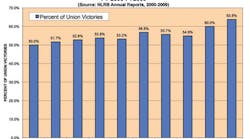By Woodruff Imberman, PHD.
Last March we reported on the National Labor Relations Board’s unprecedentedly pro-union agenda via its oversight of federal labor policies and predicted it would continue this vigorous approach. In April, it issued a complaint against Boeing for opening a non-union plant in South Carolina. In June, it published proposed changes to its rules governing union-representation elections. The NLRB plans a quick vote on them, soon. They will help union organizers, handcuff management, and fast-track representation elections when employees vote whether to unionize.
With the failure in Congress of the Employee Free Choice Act, with its “card check” unionization provision that would have eliminated nearly all representation elections, union leaders are trying a new way to achieve their organizing goals. “If you can’t legislate, regulate,” is now their strategy, using the NLRB’s regulatory authority over labor relations as their means.
The NLRB’s proposed rules upend the “level playing field” standard it has traditionally used to balance the often-conflicting interests of unions, employers, and employees. The new rules:
• Require managers to give the NLRB the names, job titles, shifts, phone numbers, home and email addresses of all workers within two days of any union organizing petition;
• Cut significantly the time of election campaigns, reducing management’s chance to tell its side of the story. Labor experts say campaigns would be cut to from about 50 days to about 20 days, start to finish;
• Limit managements' ability to inform employess about unions during an election campaign; • Defer voter-eligibility challenges and other campaign objections until after an election;
Altogether, these new rules severely restrict management efforts to tell its side of the unionization story. Already, the NLRB issued an extra-legal rule requiring employers to post notices informing workers of their right to unionize, listing the “advantages” of unions. It may also make permanent the restrictions on management that now apply only after a union files a petition.
Unions decry present election rules despite the fact that they now win nearly 64% of them. They claim the rules are cumbersome and slow. They say companies have unfair advantages, notably giving “captive audience” speeches to employees at work. Unions avoid mentioning their right to make home visits to workers to promote their claims, something denied to management.
Astute managers realize the best way to avoid elections is to treat their employees so they won’t want a union. Astute managers also know the best way to do this is to identify and eliminate irritants that cause employees to seek out unions in the first place. Experts know money is not the real reason employees vote union. Rather, workers vote to unionize because they believe they are not being treated fairly, openly, and honestly by management. That determines how employees will vote.
The first step to avoid an election is to conduct an employee audit to determine worker sentiment, i.e., test the mood on the plant floor.
Employees’ attitudes cannot be accurately assessed by simple paper-and-pencil audits many attorneys recommend. Those surveys rarely uncover the nuances of employee thinking, especially of foreign-born workers with different cultures. The best way to understand employees’ attitudes is by face-toface interviews by expert outside interviewers, because workers speak more openly to them than to management, for fear of retribution. Also, the ability to discern what employees actually mean by what they say is critical, takes much experience, and requires knowledge of modern manufacturing practices.
After experts uncover employees’ level of discontent and why they think as they do, management can address their concerns and eliminate the causes of negative worker attitudes. Often, this will require two subsequent efforts: First is supervisory training tailored to a company’s specific problems. Canned online training is inexpensive, but usually ineffective. Second is developing a compensation system to encourage productivity and employee cooperation while reinforcing the natural employee/employer bond.
Together, these efforts will improve a company’s competitiveness and render its employees virtually impervious to union organizers’ promises. After all, isn’t it better to avoid an election entirely rather than merely winning one?
Dr. Imberman is a consultant specializing in employee audits and communications, Gainsharing Plans, and other pay-for-performance programs. For more information on employee audits, contact him at tel. 847-733-0071 or [email protected].









